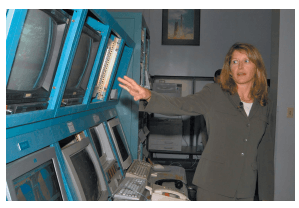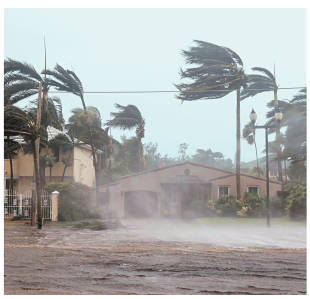
You will hear an interview with Judy Miller, CD (50). Complete the statements (1−7) with the appropriate items.
1) Judy decided to study science ... .
a) after the catastrophe she had witnessed
b) after the ‘hurricane season’
c) after the tornado
2) New Orleans is the place ... .
a) where Hurricane Katrina began
b) which opens the so−called ‘hurricane season’
c) where a natural disaster happened
3) According to Judy ... in 2005.
a) less than half of New Orleans’ territory was flooded
b) more than half of New Orleans’ territory was flooded
c) all New Orleans was flooded
4) Judy describes Katrina as ... in history.
a) the strongest tropical storm
b) one of the strongest tropical storms
c) one of the ordinary tropical storms
5) Judy mentions that ... .
a) hurricanes never happen in winter
b) hurricanes usually happen in winter
c) hurricanes sometimes happen in winter
6) Judy explains that ... .
a) hurricanes depend on the warmth of the ocean surface
b) hurricanes begin in the warm ocean water
c) hurricanes give warmth to the ocean surface
7) Judy says that ... .
a) the warmer the climate is the more hurricanes happen
b) the beginning of a hurricane is stronger than its end
c) when winds become weaker during a hurricane it means the storm is coming to its end



Перевод задания
Вы услышите интервью с Джуди Миллер, CD (50). Дополните утверждения (1−7) соответствующими пунктами.
1) Джуди решила заняться наукой ... .
a) после катастрофы, свидетелем которой она стала
b) после «сезона ураганов»
c) после торнадо
2) Новый Орлеан − это место ... .
a) где начался ураган Катрина
b) который открывает так называемый «сезон ураганов»
c) где произошло стихийное бедствие
3) По словам Джуди ... в 2005 г.
a) менее половины территории Нового Орлеана было затоплено
b) более половины территории Нового Орлеана было затоплено
c) весь Новый Орлеан был затоплен
4) Джуди описывает Катрину как ... в истории.
a) сильнейший тропический шторм
b) один из сильнейших тропических штормов
c) один из обычных тропических штормов
5) Джуди упоминает, что ... .
a) ураганов зимой не бывает
b) ураганы обычно случаются зимой
c) ураганы иногда случаются зимой
6) Джуди объясняет, что ... .
a) ураганы зависят от тепла поверхности океана
b) ураганы начинаются в теплой океанской воде
c) ураганы согревают поверхность океана
7) Джуди говорит, что ... .
a) чем теплее климат, тем больше бывает ураганов
b) начало урагана сильнее его конца
c) когда во время урагана ветер ослабевает, это означает, что шторм подходит к концу
AUDIO
Interviewer: With us today is Judy Miller, a well−known scientist. Hello, Judy, welcome.
Judy Miller: Thank you.
Interviewer: How did you happen to become so much interested in the ecological problems?
Judy Miller: I was born and grew up in the southern part of the US. I went to school in the city of New Orleans. In the summer of 2005 I was back home from my holidays preparing for the beginning of my final school year when on Sunday, I still remember the date, the 28th of August, we heard that Hurricane Katrina was on the way to the city. On Monday, the 29th, it hit New Orleans and we had a week of horror.
Interviewer: It was the disaster, in fact, that started your career, wasn’t it?
Judy Miller: It was. Actually Katrina was one of the wildest storms in history. It took 1,833 lives and caused a lot of damage. Eighty per cent of New Orleans was buried in flood water. But my family was lucky, our house wasn’t damaged. Then I felt I had to do something, so I decided to study Nature’s wildest storms and hurricanes.
Interviewer: When do such storms usually happen?
Judy Miller: During the so−called hurricane season. From June to November in the Atlantic Ocean and from May until November in the Pacific Ocean.
Interviewer: How does a hurricane start?
Judy Miller: In the Atlantic Ocean they actually begin as windy thunderstorms that are formed over the warm ocean near the equator. Then the winds pick up energy from the warm surface of the ocean.
Interviewer: What is the main danger?
Judy Miller: These major tropical storms can be very dangerous along coastlines because ocean waters flow onto land destroying everything. When this is combined with heavy rainfall, there can be awful floods.
Interviewer: Why do hurricanes happen so often?
Judy Miller: Many scientists think that warmer ocean temperatures have led to stronger tropical storms and hurricanes. So the explanation is global warming and climatic changes.
Interviewer: People say that the wildest and strongly dangerous winds suddenly stop and unusually quiet periods come and then the hurricane hits even more strongly. Why?
Judy Miller: The centre of a hurricane is called the “eye”. While most of hurricanes has dangerously strong winds, the eye is actually a calm area in the storm. When the eye of a hurricane passes over land, people usually think the storm is over, but before long the wind and rain increase again.
Перевод AUDIO
Интервьюер: Сегодня с нами Джуди Миллер, известный ученый. Привет, Джуди, добро пожаловать.
Джуди Миллер: Спасибо.
Интервьюер: Как получилось, что вы так заинтересовались экологическими проблемами?
Джуди Миллер: Я родилась и выросла в южной части США. Я ходила в школу в городе Новый Орлеан. Летом 2005 года я вернулась домой с каникул, готовясь к началу последнего учебного года, когда в воскресенье, я до сих пор помню дату, 28 августа, мы услышали, что ураган Катрина приближается к городу. В понедельник, 29−го, он обрушился на Новый Орлеан, и у нас была неделя ужаса.
Интервьюер: На самом деле, это была катастрофа, с которой началась ваша карьера, не так ли?
Джуди Миллер: Это так. На самом деле Катрина была одной из самых диких бурь в истории. Он унес 1833 жизни и причинил большой ущерб. Восемьдесят процентов Нового Орлеана были затоплены паводковыми водами. Но моей семье повезло, наш дом не пострадал. Затем я почувствовала, что должна что−то сделать, и решила изучить самые дикие штормы и ураганы в природе.
Интервьюер: Когда обычно бывают такие бури?
Джуди Миллер: Во время так называемого сезона ураганов. С июня по ноябрь в Атлантическом океане и с мая по ноябрь в Тихом океане.
Интервьюер: Как начинается ураган?
Джуди Миллер: В Атлантическом океане они фактически начинаются как ветреные грозы, которые формируются над теплым океаном вблизи экватора. Затем ветры подбирают энергию с теплой поверхности океана.
Интервьюер: В чем главная опасность?
Джуди Миллер: Эти сильные тропические штормы могут быть очень опасными вдоль побережья, потому что океанские воды стекают на сушу, уничтожая все вокруг. Когда это сочетается с сильными дождями, могут быть ужасные наводнения.
Интервьюер: Почему так часто случаются ураганы?
Джуди Миллер: Многие ученые считают, что повышение температуры океана привело к более сильным тропическим штормам и ураганам. Так что объяснение − глобальное потепление и климатические изменения.
Интервьюер: Говорят, что самые дикие и сильно опасные ветры внезапно прекращаются и наступают необычно спокойные периоды, а потом ураган бьет еще сильнее. Почему?
Джуди Миллер: Центр урагана называется «глаз». В то время как у большинства ураганов есть опасные сильные ветры, глаз на самом деле является спокойной зоной во время шторма. Когда глаз урагана проходит над землей, люди обычно думают, что буря закончилась, но вскоре ветер и дождь снова усиливаются.
ОТВЕТ
1 − a, 2 − c, 3 − b, 4 − b, 5 − a, 6 − a, 7 − a.
1) Judy decided to study science after the catastrophe she had witnessed.
2) New Orleans is the place where a natural disaster happened.
3) According to Judy more than half of New Orleans’ territory was flooded in 2005.
4) Judy describes Katrina as one of the strongest tropical storms in history.
5) Judy mentions that hurricanes never happen in winter.
6) Judy explains that hurricanes depend on the warmth of the ocean surface.
7) Judy says that the warmer the climate is the more hurricanes happen.
Перевод ответа
1 − a, 2 − c, 3 − b, 4 − b, 5 − a, 6 − a, 7 − a.
1) Джуди решила заняться наукой после катастрофы, свидетелем которой она стала.
2) Новый Орлеан − это место, где произошло стихийное бедствие.
3) По словам Джуди, более половины территории Нового Орлеана было затоплено в 2005 году.
4) Джуди описывает Катрину как один из сильнейших тропических штормов в истории.
5) Джуди упоминает, что ураганов зимой не бывает.
6) Джуди объясняет, что ураганы зависят от тепла поверхности океана.
7) Джуди говорит, что чем теплее климат, тем больше ураганов бывает.
Пожалуйста, оцените решение